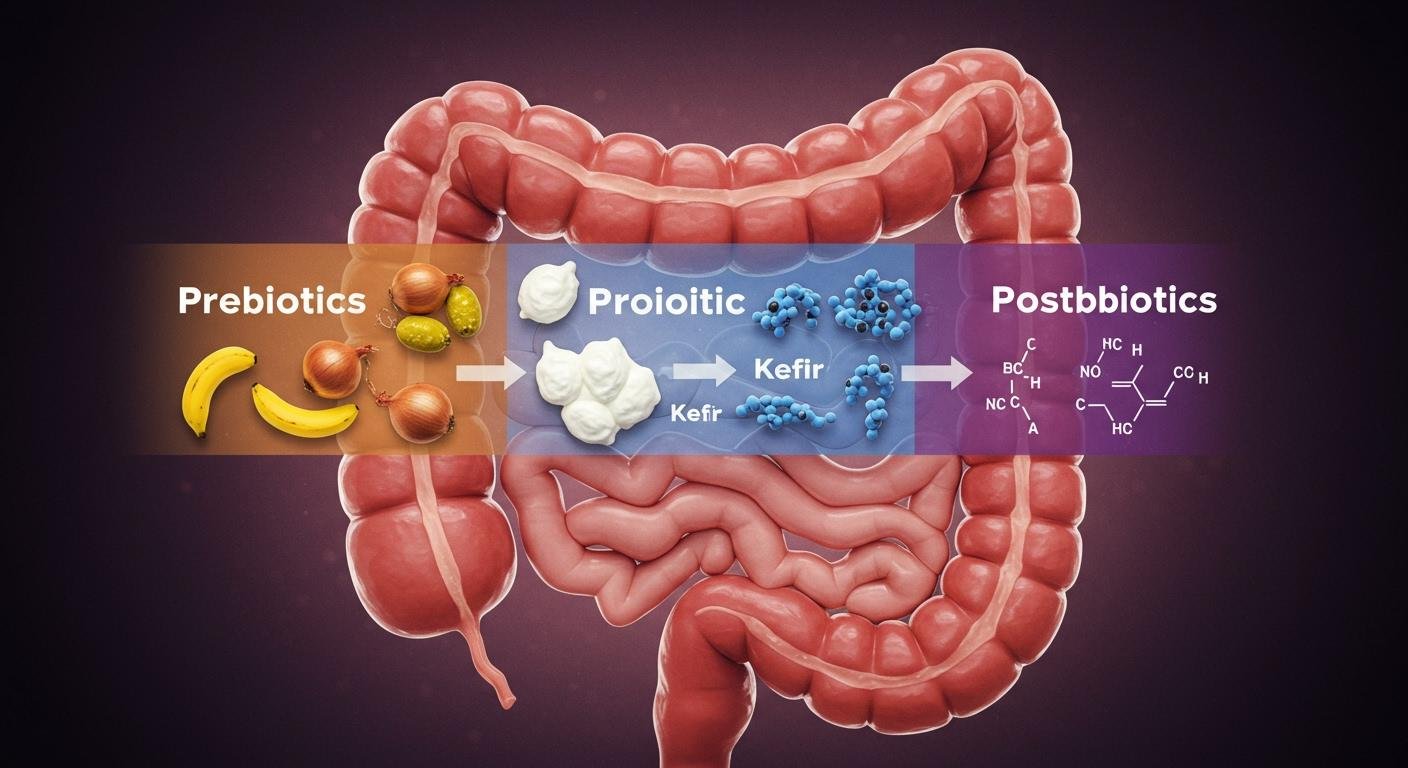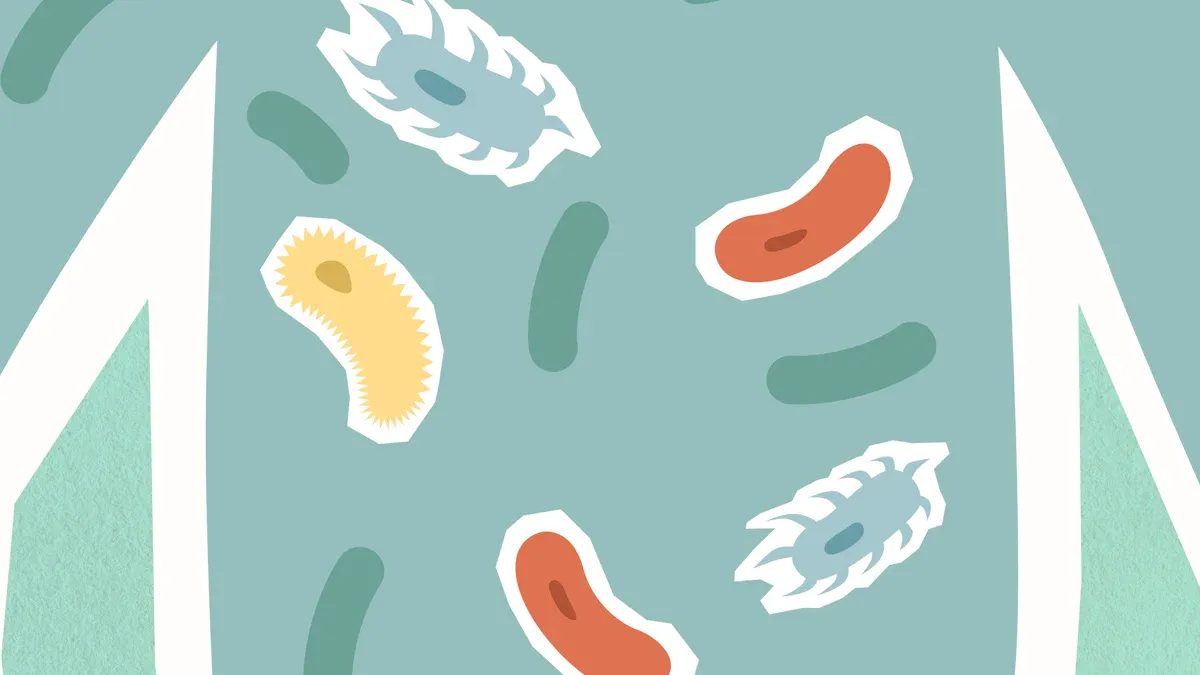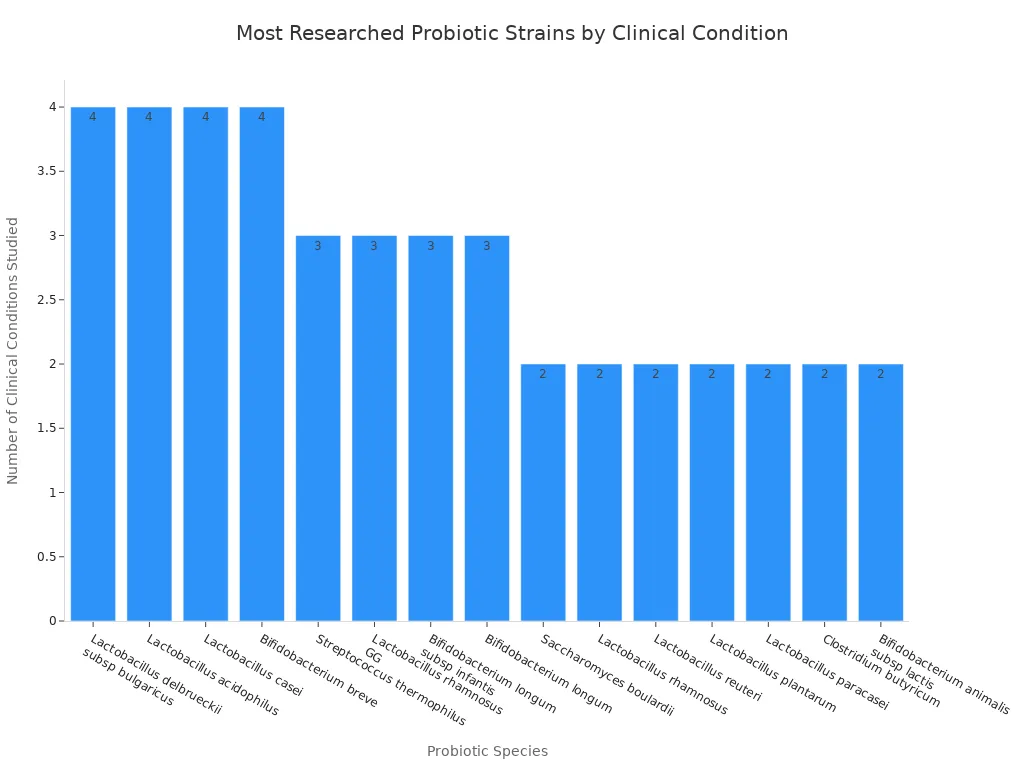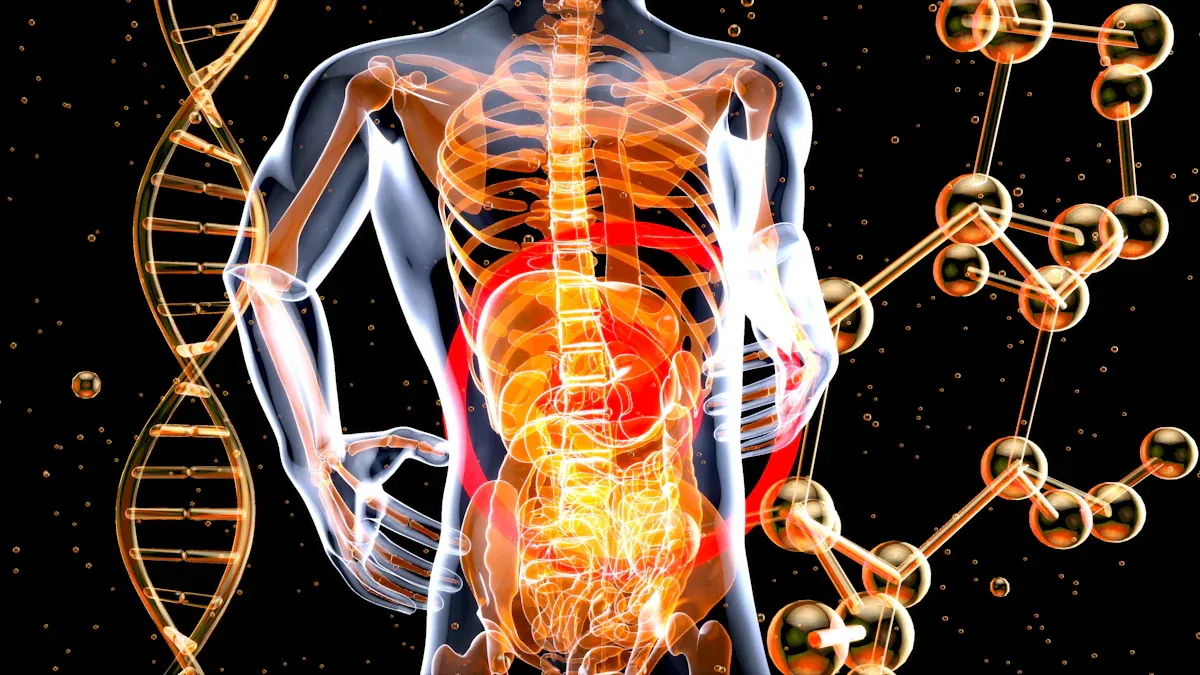Prebiotics vs Probiotics vs Postbiotics A Gut Guide
Table of Contents

Think of your gut as a garden. Probiotics are the helpful seeds, prebiotics are the fertilizer that helps them grow, and postbiotics are the healthy fruits they produce.
This matters because nearly 40% of people worldwide face gut-related health problems. Your healthy gut communicates directly with your brain, influencing your mood and overall well-being. Understanding the relationship in prebiotics vs probiotics vs postbiotics is your first step toward better gut health and overall health.
PREBIOTICS VS PROBIOTICS VS POSTBIOTICS: THE KEY DIFFERENCES

You now know the three ‘biotics’ are different. Let’s explore what truly sets them apart. Understanding these differences helps you make smarter choices for your gut health.
A SIMPLE ANALOGY
Let’s return to our garden analogy. It is the easiest way to picture the unique job of each ‘biotic’.
Imagine your gut garden is empty. You first need to plant good seeds. These seeds are your probiotics 🦠. Next, you must feed those seeds with a special fertilizer so they can grow strong. That fertilizer is your prebiotics 🌾. As your healthy seeds grow, they produce valuable fruits and vegetables. These nutritious harvests are your postbiotics 🍎.
Without all three, your garden cannot flourish. You need the seeds, the fertilizer, and the final harvest for a complete, healthy ecosystem.
COMPARING THEIR ROLES
The garden analogy is helpful, but the scientific distinction in prebiotics vs probiotics vs postbiotics is also important. Each one has a different structure and performs a specific function inside your body. Probiotics are living organisms, while prebiotics are dietary fibers. Postbiotics are the beneficial compounds produced after probiotics consume prebiotics.
This table offers a clear breakdown of their distinct jobs:
| Category | What It Is | Key Function |
|---|---|---|
| Probiotics | Live beneficial bacteria and yeasts | They add to the population of good microbes in your gut, support immune function, and help keep harmful microbes in check. |
| Prebiotics | Special plant fibers that your body can’t digest | They act as food for the good bacteria already in your gut, helping them grow and thrive. This process produces beneficial compounds. |
| Postbiotics | Health-promoting compounds made by probiotics | These are the “end products.” They help strengthen your gut barrier, reduce inflammation, and provide direct health benefits. |
The different roles of probiotics and prebiotics can lead to different health outcomes. For example, a clinical study looked at people with Major Depressive Disorder. One group took probiotics, another took prebiotics, and a third took a placebo. After eight weeks, the group taking probiotics showed a significant improvement in their depression scores. The group taking prebiotics did not show the same level of benefit. This shows how directly adding live bacteria can sometimes have a more targeted impact than just providing fuel.
| Feature | Probiotics | Postbiotics |
|---|---|---|
| Stability | Lower; they are live cells that can die easily. | Higher; they are not alive and are very stable. |
| Storage | Often require refrigeration or special packaging. | Easier to store and add to different products. |
Understanding the core differences in prebiotics vs probiotics vs postbiotics is key. You are not just choosing one over the other. You are learning how to supply your body with the living organisms, the fuel, and the finished products it needs to function at its best.
UNDERSTANDING PROBIOTICS
Probiotics are the “good seeds” for your gut garden. You can add these helpful organisms to your body to support your overall health. Let’s explore what they are and how they work.
WHAT ARE PROBIOTICS?
Probiotics are beneficial living microorganisms, like bacteria and yeasts. However, not every live culture in food qualifies. For a microbe to be officially called a probiotic, it must meet strict scientific criteria.
- It must be alive when you take it.
- It must have a proven health benefit documented in studies.
- It must be taken in a large enough dose to provide that benefit.
The most common and well-researched probiotics belong to groups like Bifidobacterium and Lactobacillus. These are the types of probiotic bacteria you often see in probiotic products.
WHAT DO PROBIOTICS DO?
Probiotics perform several vital jobs to keep your gut and body healthy. They help balance your gut microbiota, which is the community of trillions of microbes living in your digestive tract. A balanced microbiome is crucial for good health.
These powerful microbes directly support your immune system. Probiotics interact with your immune cells to help maintain balance and control inflammation. They also help restore your gut microbiome after it has been disrupted, such as by a course of antibiotics. Studies show that taking probiotics can preserve microbial diversity and reduce the growth of harmful bacteria. For people with certain digestive issues, specific probiotics have been shown to improve symptoms.
Different strains offer different health benefits. The chart below shows some of the most researched probiotic strains and the number of health conditions they have been studied for.

FOOD SOURCES OF PROBIOTICS
You can easily add probiotics to your diet through fermented foods. These foods are rich in live cultures that support your gut microbiota. Different foods contain different strains and amounts of probiotics.
- Kefir: Contains around 27 billion CFUs (Colony Forming Units) per cup.
- Yogurt: Contains about 3.6 billion CFUs per cup.
- Kimchi: Contains about 2.6 billion CFUs per half cup.
Dairy-based foods like yogurt and kefir are typically rich in Lactobacillus and Bifidobacterium strains. Including a variety of these foods helps diversify your gut bacteria. If you struggle to get enough from food, you can also find probiotics available as dietary supplements to support your digestion and gut health.
THE ROLE OF PREBIOTICS
If probiotics are the seeds in your gut garden, prebiotics are the specialized fertilizer. They provide the essential food your beneficial gut bacteria need to grow, multiply, and support your overall health.
WHAT ARE PREBIOTICS?
Prebiotics are a type of plant fiber that your body cannot digest. Instead, they travel to your large intestine, where they become a food source for your gut microbiota. Chemically, many common prebiotics like inulin and fructooligosaccharides (FOS) are made of fructose sugar chains. Your digestion enzymes cannot break these chains apart, but specific gut microbes can.
For a substance to be officially classified as a prebiotic, it must meet several scientific criteria. It is not just any fiber; it must be a targeted food source that provides proven health benefits.
| Prebiotic Criteria | Description |
|---|---|
| Selective Use | It must be selectively used by your beneficial microorganisms. |
| Health Benefit | It must provide a demonstrated health benefit in studies. |
| Mechanism | There must be a clear reason why it helps your microbiome. |
| Safety | It must be safe for you to consume at an effective dose. |
HOW PREBIOTICS WORK
Understanding how to use prebiotics is simple: you eat them, and your gut bacteria do the rest. When these fibers reach your colon, beneficial bacteria like Bifidobacteria and Lactobacilli begin to ferment them. This fermentation process is how the bacteria “eat” the prebiotics.
This process is vital for your health. As the bacteria break down the prebiotic fibers, they produce beneficial compounds, including short-chain fatty acids (SCFAs). These SCFAs help strengthen your gut lining, reduce inflammation, and provide energy for your colon cells. This activity selectively boosts the populations of good bacteria, helping to maintain a balanced gut microbiota and a healthy microbiome.
FOOD SOURCES OF PREBIOTICS
You can easily increase your intake of prebiotics by including more fiber-rich plants in your diet. Many common foods are excellent sources of these beneficial fibers. Adding a variety of prebiotic-rich foods helps nourish a diverse gut microbiota.
Some of the best food sources include:
- Garlic
- Onions
- Leeks
- Asparagus
- Bananas (especially when slightly green)
- Oats
Health organizations recommend that adults consume 25 to 38 grams of dietary fiber per day. While this goal was set for general digestion and heart health, meeting it also helps fuel your gut bacteria and supports your entire gut ecosystem.
INTRODUCING POSTBIOTICS
You have learned about the seeds (probiotics) and the fertilizer (prebiotics). Now, let’s talk about the harvest: postbiotics. These are the valuable, health-promoting compounds your gut microbiota produces. They offer direct health benefits to your body.
WHAT ARE POSTBIOTICS?
Postbiotics are the beneficial byproducts created when your good gut bacteria ferment prebiotic fiber. The International Scientific Association for Probiotics and Prebiotics (ISAPP) provides a clear definition.
Unlike probiotics, postbiotics are not living organisms. This makes them very stable. These compounds include a variety of helpful substances that support your overall health. Some key examples of postbiotics are:
- Short-chain fatty acids (SCFAs) like butyrate
- Peptides, which are small protein fragments
- Cell wall components from bacteria
- Vitamins and amino acids
THE BENEFITS OF POSTBIOTICS
Postbiotics deliver powerful health benefits directly to your gut and body. One of their most important jobs is to strengthen your gut barrier. Certain postbiotics help tighten the junctions between your intestinal cells. This prevents harmful substances from leaking into your bloodstream. They also help reduce inflammation. Research shows that the SCFA butyrate can calm inflammatory responses in your colon cells. This is a key reason why a healthy gut microbiota is so important for managing inflammation. These actions support your immune system and contribute to a balanced microbiome.
HOW POSTBIOTICS ARE CREATED
Your body creates postbiotics through a natural process involving your gut microbiota. It starts when you eat prebiotic-rich foods. These fibers travel through your digestive system untouched until they reach your colon. There, your beneficial gut bacteria feast on these fibers. This fermentation process is essential for good digestion. As the bacteria break down the fibers, they release the valuable compounds we call postbiotics. This amazing teamwork between prebiotics and probiotics produces the finished products your body uses to stay healthy.
A STRATEGY FOR BETTER GUT HEALTH

Understanding the ‘biotics’ is the first step. Now, you can use this knowledge to build a powerful strategy for better gut health. It involves combining the right foods and adopting supportive lifestyle habits.
HOW THE ‘BIOTICS’ WORK TOGETHER
Prebiotics, probiotics, and postbiotics form a powerful team for your gut. Probiotics need prebiotics as fuel to produce beneficial postbiotics. This synergy is so effective that some products, called synbiotics, combine both probiotics and prebiotics. This combination helps the helpful bacteria survive their journey through your gut.
Studies show this teamwork delivers real results. In one clinical trial, a synbiotic mixture improved key glycemic markers in patients with type 2 diabetes more effectively than probiotics alone. This shows how combining the seeds (probiotics) and fertilizer (prebiotics) creates a greater health benefit.
This process is key for a healthy gut. The probiotics ferment the prebiotics, creating the postbiotics that strengthen your gut lining and support your overall health.
BUILDING A GUT-FRIENDLY PLATE
You can create a healthy and diverse gut environment by focusing on your plate. The goal is variety. Research shows that people who eat 30 or more different types of plants each week have a more diverse gut microbiome than those who eat fewer than 10. This diversity is crucial for a robust gut microbiota.
So, how to use prebiotics and probiotics in your diet?
- Add Probiotics: Include fermented foods like yogurt, kefir, and kimchi.
- Fuel with Prebiotics: Eat a wide range of plant foods like onions, garlic, oats, and bananas.
Each plant food offers unique prebiotics and nutrients, feeding different types of good bacteria. This helps your gut microbiota flourish and produce valuable postbiotics.
LIFESTYLE AND GUT HEALTH
Your daily habits also shape your gut. Chronic stress can harm your gut microbiome, leading to imbalances and even a “leaky gut.” This allows harmful substances to enter your bloodstream and trigger inflammation.
On the other hand, positive habits build a healthier gut.
- Exercise Regularly: Physical activity can increase the diversity of your gut microbiota. It boosts beneficial bacteria that produce health-promoting postbiotics.
- Prioritize Sleep: Good sleep quality is linked to a healthier gut microbiota. Exercise can also improve sleep, creating a positive cycle for your gut and overall well-being.
Managing stress and staying active are simple yet powerful ways to support the work of prebiotics and probiotics in your body.
Remember the key to a healthy gut. You need the workers (probiotics), the right fuel for them (prebiotics), and the valuable goods they create (postbiotics).
You do not need to perfectly track the details of prebiotics vs probiotics vs postbiotics. Instead, focus on a simple goal for your gut. Eat a diverse diet with plenty of plants for prebiotics and fermented foods for probiotics. Adding these probiotics naturally supports your entire gut ecosystem and builds lasting health.
FAQ
Can I take prebiotics and probiotics together?
Yes, you can. Taking them together is very beneficial. This combination is called a synbiotic. The prebiotics provide food for the probiotics, helping them work more effectively in your gut. This teamwork gives you a greater health advantage.
How long does it take for probiotics to work? 💊
The timing varies for everyone. You might notice improvements in a few days, or it could take several weeks. The key is consistency. You should take them regularly to give the beneficial bacteria time to establish themselves in your gut.
Do I need a postbiotic supplement?
Most people do not need a postbiotic supplement. Your body naturally creates postbiotics when your gut bacteria ferment prebiotic fiber. You can support this process by eating a diet rich in fiber and fermented foods.
What is the most important ‘biotic’? 🍽️
No single ‘biotic’ is most important. They all have unique and essential roles. The discussion of prebiotics vs probiotics vs postbiotics shows they work as a team. You need the seeds, the fertilizer, and the final harvest for a healthy gut.

Poseidon
Master of Nutritional Epidemiology, University of Copenhagen, Herbal Functional Nutrition Researcher
Focus: The scientific application of natural active ingredients such as Tongo Ali, Horny Goat Weed, and Maca to sexual health and metabolic regulation.
Core Focus:
Men: Use a combination of Tongo Ali (an energizing factor) + Maca (an energy reserve) to improve low energy and fluctuating libido.
Women: Use a combination of Horny Goat Weed (a gentle regulator) + Maca (a nutritional synergist) to alleviate low libido and hormonal imbalances.
Stressed/Middle-Aged Adults: This triple-ingredient synergy supports metabolism, physical strength, and intimacy.
Product Concept:
Based on traditional applications and modern research (e.g., Tongo Ali promotes testosterone-enhancing enzyme activity, and icariin provides gentle regulation), we preserve core active ingredients and eschew conceptual packaging—using natural ingredients to address specific needs.
Simply put: I'm a nutritionist who understands "herbal actives." I use scientifically proven ingredients like Tongo Ali, Epimedium, and Maca to help you make "sexual health" and "nutritional support" a daily routine.
